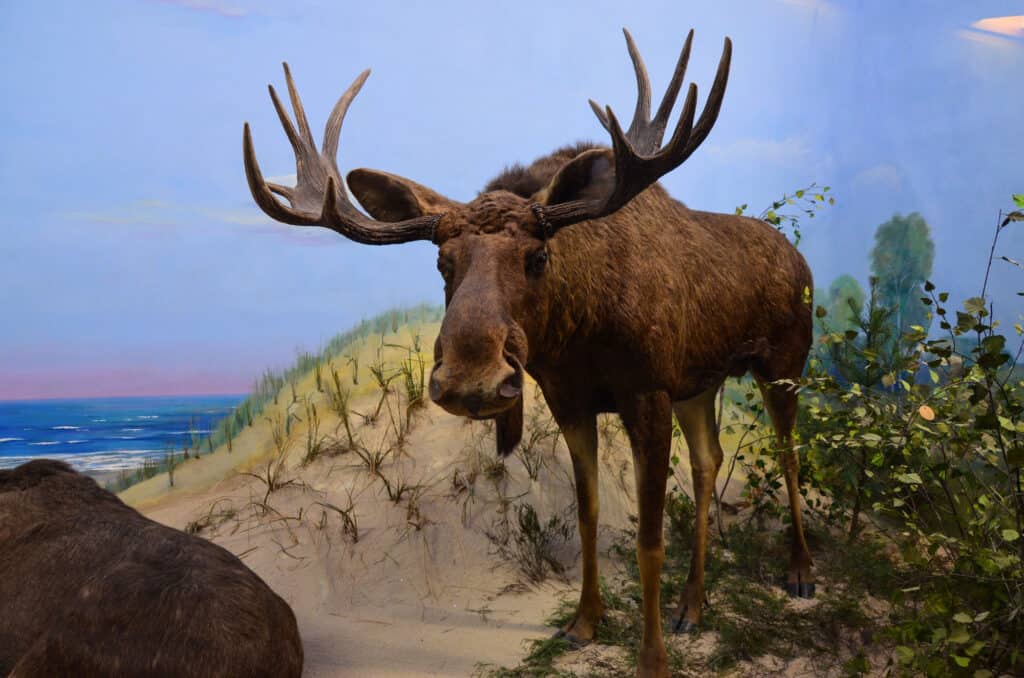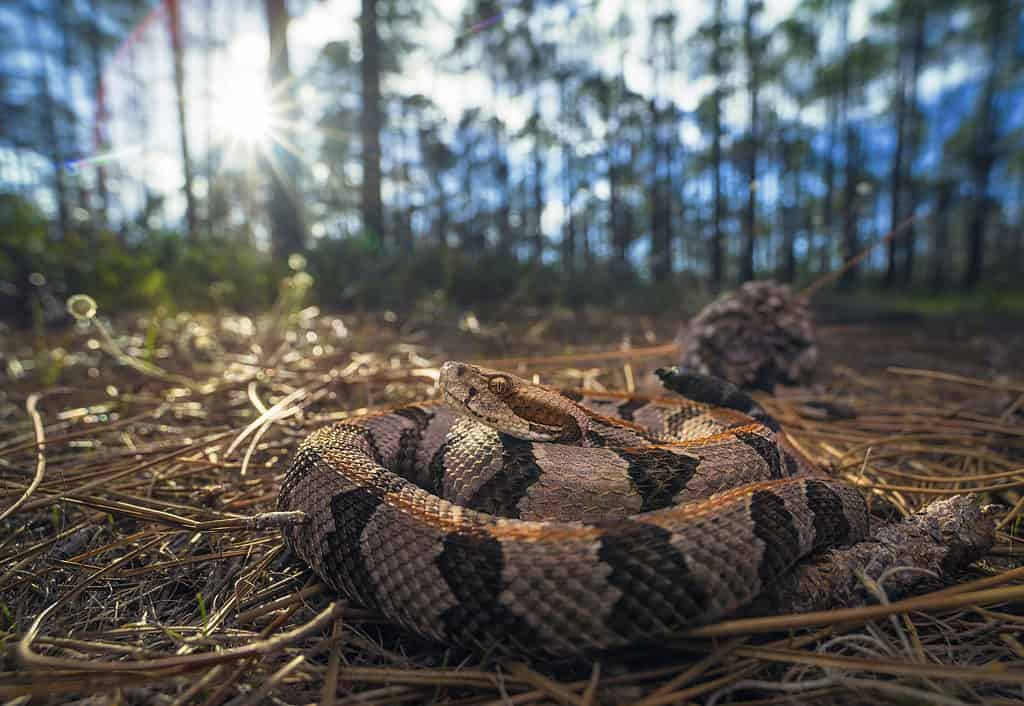With 85% of the state covered in forests, New Hampshire is the second most forested state next to Maine. I can think of a few animals I would not want to encounter in the forest, but are any of them deadly? New Hampshire also has a small coastline along the Atlantic Ocean and I know there are deadly animals in the ocean, but have there ever been any fatalities off the coast of New Hampshire?
What about poisonous or venomous animals in the state. With long winters in this northern state are there any spiders or snakes that can survive the winter? One news story reports about a “Giant Jellyfish” in the state, how are jellyfish dangerous? Let’s take a look at some of the dangerous animals in New Hampshire.
What are the most dangerous animals in the forests of New Hampshire?

Moose are common across northern New Hampshire.
©D.serra1/Shutterstock.com
With so many forests, New Hampshire has its fair share of large animals that can present danger. Then there’s also disease-carrying insects on these animals.
- Black bears: With all of the forests in New Hampshire it should not come as a surprise that much of the state is considered Bear Country. There is estimated 4,800-5,000 black bears that live in the state resulting in an average of 600 bear-human conflicts a year. “The Bear Lady” as she is called is Nancy Comeau who is a Bear Technician for the State that is working to help bears and humans to coexist. She recommends things like taking your bird feeder down between April and December and using a bear-proof trash receptacle to reduce the temptations that may bring a bear into populated areas. Despite the number of bear incidents, there are few actual attacks and there has not been a fatality in New Hampshire since the late 1700s.
- Moose: These large antlered animals are bigger than you may think. One standing next to you could be 6 feet tall at the shoulder and weigh up to 1,500 lbs. That is why it is better to keep your distance from them if you do encounter one. Back in 2014, a couple from New Hampshire videotaped an encounter where a moose charged them while snowmobiling. They were snowmobiling on a trail behind a moose that suddenly stopped and turned around and approached the man. He tried to keep the snowmobile between him and the giant moose but the moose did make contact but did not injure the man. Luckily it was in the winter when the moose did not have any antlers as they shed them each fall and regrow new ones. Moose attacks are rare and there are not any recorded moose-related fatalities in New Hampshire. Just be careful when driving, in 2021 there were 72 moose killed by vehicles in the state.
- Deer Ticks: These tiny ticks can latch on to suck your blood which is disturbing, but the problem with deer ticks is that they can carry Lyme disease. According to the Mayo Clinic, “You’re more likely to get Lyme disease if you live or spend time in grassy and heavily wooded areas where ticks carrying Lyme disease thrive.” Which just makes sense. They go on to add that the majority of tick bites do not lead to Lyme disease and if the tick has been attached for less than 36-48 hours Lyme infection is unlikely. So if you have been in tall grass or the woods it is best to check yourself for ticks when you get in.
Are there any poisonous or venomous animals in New Hampshire?

Timber rattlesnakes are the only venomous snake in New Hampshire
©Kristian Bell/Shutterstock.com
There are 11 types of snakes in New Hampshire, but only one is venomous.
- Timber Rattlesnake: There is only one species of venomous snake in New Hampshire and they are so rare that they are protected by the state, so it is highly unlikely you would encounter one. Timber rattlers are large snakes that are mostly black with faded markings. Rattlesnakes have a more triangular head and a rattle for a tail, which they will use to warn others. If you happened to see one and happened to get bit then you would need to seek medical attention.
- Black Widow spiders: Black widows do exist in New Hampshire, but there are very few of them. They are located mostly in southern states where the climate is milder. The female black widows are the only ones that seem to affect humans and many times people will not have any reaction but you should seek medical attention if it is needed.
With a few beaches on the Atlantic Ocean, what dangerous animals are at the beach?

Great white sharks can be spotted off the coast of New Hampshire during warmer months as they migrate north.
©Willyam Bradberry/Shutterstock.com
New Hampshire has a scattering of beaches along the coast of the Atlantic Ocean including Hampton Beach. The scariest animal of the ocean is the shark and there are sharks off the coast. Some of the sharks that can be seen are the blue, makos, basking, thresher, dogfish, and great white. Since sharks are cold-blooded, their temperature matches that of the water they swim in, so during the cold New Hampshire winters most of the sharks migrate south to find warmer water. There have not been any shark attacks in New Hampshire but there was a fatal shark attack in Maine, not far from the border. On July 27, 2020, Julie Dimperio Holowach, a 63-year-old woman, was killed by a shark while she was swimming off of Bailey Island, Maine which is about 100 miles from Hampton Beach. Based on the bite marks it was confirmed as a great white, which is the kind of shark that is responsible for the most fatal attacks. Even though this is a tragic story, stories like this are rare with only 9 unprovoked attack fatalities in 2021, worldwide!
Are there really “Giant Jellyfish” in New Hampshire?
The headline was, “Giant Dead Jellyfish Stings 150 People on New Hampshire Beach”. It got me to read the article. Sure enough, a Lion’s Mane Jellyfish, the largest of the jellyfish washed up on shore. The long tentacles can detach from a jellyfish and continue floating in the water. Even though the jellyfish is dead, the tentacles can release venom when it comes into contact with someone, so one could graze you while swimming or you could accidentally step on one on the beach. The 150 beachgoers that got stung were mostly treated by the lifeguards by soaking the bite area in vinegar and baking soda, but five of them did go to the hospital where they were treated. This story was out of Rye, NH at Wallis Sands State Park with the Fire Lieutenant describing it as the size of a trash can lid and weighing around 50lbs. with tentacles that were around 20-25 feet long. According to National Aquarium, the Lion’s Mane can get to be 8 feet wide and have tentacles that are 120 feet long! Now that is a giant jellyfish!
The photo featured at the top of this post is © iStock.com/bbevren
Thank you for reading! Have some feedback for us? Contact the AZ Animals editorial team.






